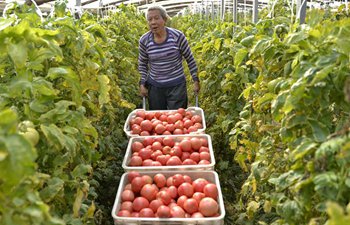BEIJING, Nov. 6 (Xinhua) -- With increasing international challenges, including fragmentation in free trade arrangements, China has always been vigrously promoting a regional free trade pact in the Asia-Pacific that is open, inclusive and beneficial to all.
China has on many occasions called for attentions to the diversity and difference in development levels of the economies in the region in a bid to avoid fragmental and exclusive deals.
It is also vehemently enhancing openness of its own economy and actively providing public goods embodied by the initiative on the construction of the Silk Road Economic Belt and the 21st Century Maritime Silk Road (Belt and Road Initiative) and regional cooperative financial tools.
ALL-INCLUSIVE AND WIN-WIN RESULT
At the APEC Economic Leaders' Meeting in Lima last year, Chinese President Xi Jinping urged the APEC economies to stay committed to pushing economic globalization forward, increasing openness of the Asia-Pacific economy, breaking bottlenecks in regional inter-connectivity and blazing new trails in reform and innovation.
Xi hailed the smooth completion of the collective strategic study on a Free Trade Area of the Asia-Pacific (FTAAP), which was launched at the 2014 APEC meeting in Beijing.
"We need to stick to our agenda and take more effective actions to realize the FTAAP at an early date, thus bringing about an Asia-Pacific economy with greater openness," said the Chinese president.
China's efforts to advance the broad trade deal across the Asia-Pacific was hailed by APEC Executive Director Alan Bollard.
The FTAAP, an idea around for some time, has received a big boost with the strategic study during China's hosting year in 2014, he said in a recent interview with Xinhua, ahead of the 25th APEC leaders' meeting to be held in Da Nang, Vietnam on Nov. 10-11.
Bollard has observed fallouts such as the United States moving out of the Trans-Pacific Partnership (TPP), as well as developments including progress in talks on Regional Comprehensive Economic Partnership (RCEP) with Chinese contribution.
The RCEP is a proposed free trade agreement between the 10 member states of the Association of Southeast Asian Nations (ASEAN) and the six countries with which ASEAN has existing free trade agreements -- Australia, China, India, Japan, South Korea and New Zealand.
The 16 RCEP participating countries account for almost half of the world's population, and contribute over a quarter of its exports and some 30 percent of global gross domestic product (GDP).
China is willing to, along with ASEAN, push ahead talks on the RCEP, said Chinese Vice Premier Zhang Gaoli during a China-ASEAN expo in Nanning, capital of southwest China's Guangxi Zhuang Autonomous Region, in September.
The Philippines, the host of a RCEP ministerial meeting in the same month, lauded China's efforts in pushing for concrete results in talks toward establishing the RCEP.
Philippine Trade Secretary Ramon Lopez said the Chinese delegation led by the minister and a vice minister of the Chinese Ministry of Commerce "have shown a strong cooperative attitude and strong support to the ongoing (RCEP) process."
A ROLE FOR BELT & ROAD INITIATIVE
China has been a major proponent of multilateral free trade, noted Jayant Menon, a leading economist of the Asian Development Bank (ABD), in a recent interview with Xinhua.
The China-proposed Belt and Road Initiative "is a key program to increase connectivity within the region, and between the region and the rest of the world. Trade costs are directly related to the level of connectivity, and as these costs come down, integration is certain to rise," said Menon.
The Belt and Road Initiative was proposed by China in 2013 to bring together countries in Asia, Europe and Africa via overland and maritime networks.
Since the initiative was launched in 2013, Chinese businesses have helped build 75 economic and trade cooperation zones in 24 countries along the Belt and Road, generating over 209,000 jobs.
"We watched China's Belt & Road Initiative with interest," said Bollard.
"It's about investment, projects and development of infrastructures," said the APEC executive director.
A recent report by United Nations Conference on Trade and Development showed that ASEAN would need infrastructure investment of 60 billion to 146 billion U.S. dollars per annum up until 2025.
Mey Kalyan, senior advisor to the Supreme National Economic Council of Cambodia, said the initiative linked very well with the ASEAN Master Plan on Connectivity that would create vast opportunities for ASEAN and China to cooperate and serve as engines for future development and prosperity.
Song Guoyou, director of Economic Diplomacy Studies Center of Fudan University in Shanghai, said the Belt and Road Initiative would promote regional economic integration and deeper globalization.
SPILLOVER EFFECTS FROM CHINA'S DEVELOPMENT
China's development offers opportunity to the Asia-Pacific, which accounts for 40 percent of the world population, around half of world trade, and 57 percent of the global GDP.
As one of the world's biggest industrial powers, the nation has exported industrialization to other developing countries and developed new technology in cooperation with developed countries -- an example of mutual benefit and quality growth.
Since China adopted the policy of reform and opening up in 1978, flows of commodities, capital and people have surged across the nation's border. The development of China's overseas interests has not only been driven by the nation's internal economic and social growth, but also has been a result of increasing international exchanges and accelerated globalization.
China offers a sustainable and inclusive development philosophy, or development ideas with universal significance and Chinese characteristics, said Ma Yao, a researcher with the Shanghai International Studies University.
While ensuring China's sovereignty, security and development interests, the country will remain committed to reform and opening up and adopt a mutually-beneficial and higher-quality approach to opening up, said President Xi while meeting with a Tsinghua University delegation last month.
"As a beneficiary of and contributor to economic globalization, China's development is an opportunity for the world. China's opening up is not a zero-sum game but win-win cooperation," Xi said.















